So, You Think You Love Horses?
Some Reflections on the Nature of Horses and Man
More Discussions by “The Accidental Horseman”
The History of the Horse as a Species
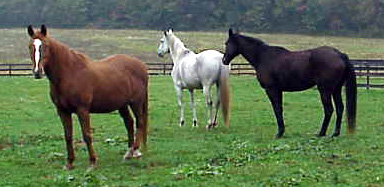
There were two prerequisites to have had horses in the world. The first was to get rid of all those dinosaurs. That happened some 66 million years ago during the K-T extinction event when a massive asteroid struck North America. The impact produced the Chicxulub crater, which measures more than 105 miles in diameter. It was not so much the impact itself but the cloud of dust it produced that caused climate change and a massive extinction of life.
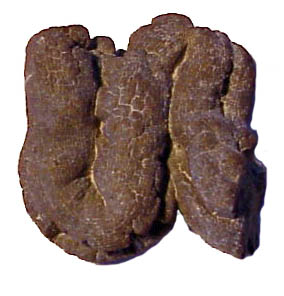
A example of a Hadrosaur Coprolite from the Cretaceous
Microscopic remnants of early grass can be found in coprolites similar to this.
(Saskatchewan, Canada)
The second prerequisite to have horses was grass. As a grazing animal, horses need grass. Grass has been covering lawns and pastures ever since I can remember, and we can be forgiven if we believe it has been there since the dawn of time, but such is not the case. True grasses are relative newcomers to the plant kingdom. Grasses were adapted to live in cooler, drier climates and to be more difficult for herbivores to digest. The earliest evidence of grass species is found in dinosaur coprolites (fossilized manure) from India, dating from the Late Cretaceous period. However, grasses did not take off until more recently, during the middle Miocene Epoch (10-20 million years ago). An overall cooling trend caused a retreat of tropical ecosystems and the expansion of deserts, tundra, and grasslands at the expense of jungles. Nature is a wonderful entrepreneur, and it wasted no time filling these new niches with fast-running herbivores that could survive in an open habitat. One of these animals was the ancestor of the modern horse.
Hyracotherium Skeleton
After Cope
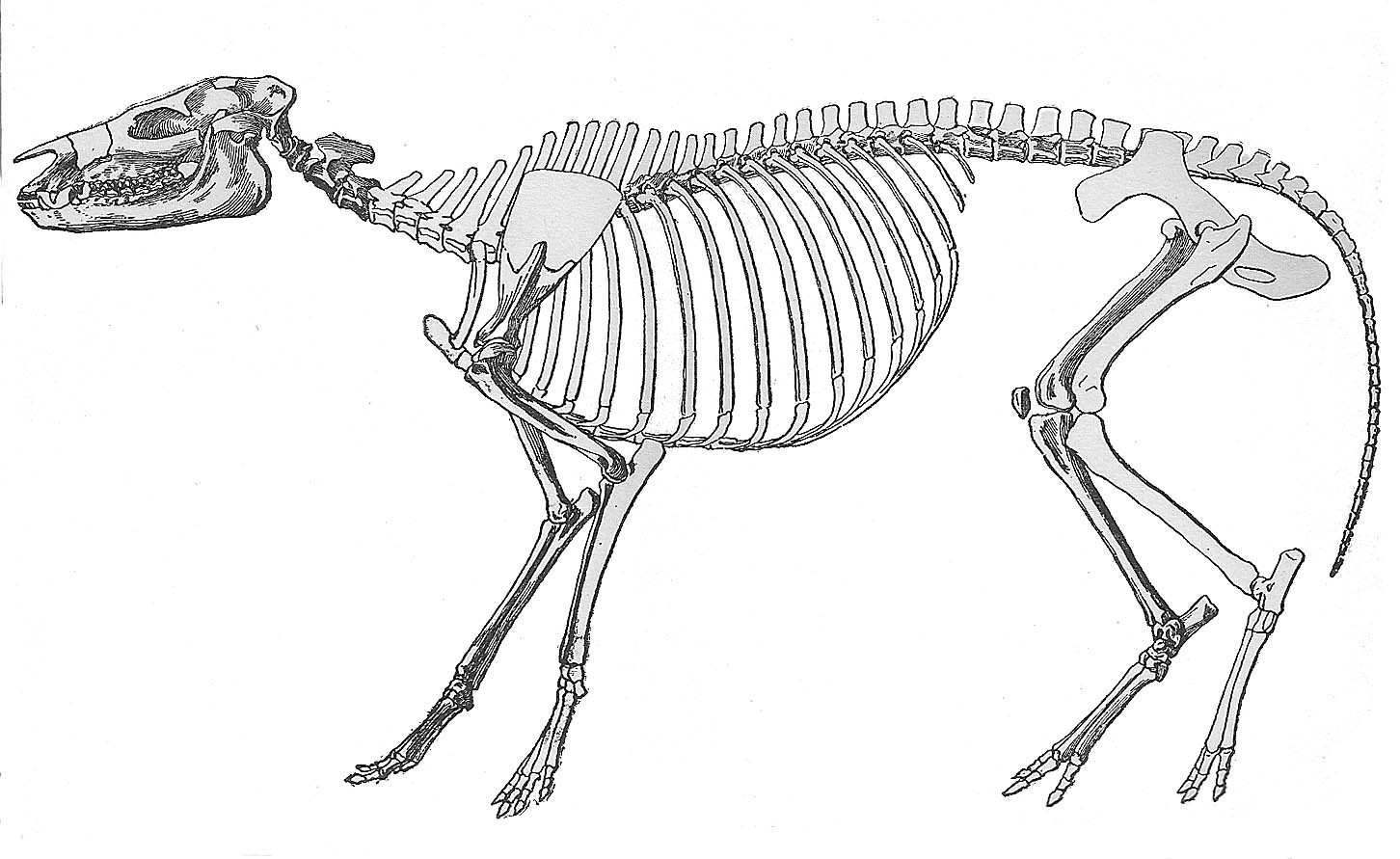
|
Hyracotherium Jaw Fragment
Willwood formation, WY
Eocene 50 Million Years Old
|
| 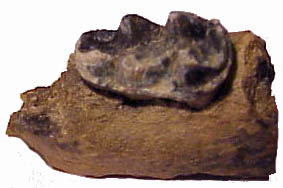
|
We have a fairly good fossil record of the progenitors of modern horses. That is not surprising since in nature herbivores far outnumber carnivores, much in the same way that taxpayers outnumber members of Congress. Therefore, one is much more likely to find a fossil of an herbivore than a carnivore. In fact, the fossil record of the horse is so good in terms of the existence of intermediate forms that it is often used to illustrate the entire notion of the process of evolution. I might mention that the horse is not alone in that regard. The intermediate forms of whales from a hippopotamus-like swamp dweller to a streamline ocean creature is even better documented. The evolutionary trends leading from the early horse-like forms to modern horses were principally the evolution of the single toe hoof, dentition adapted to grass eating and adaptations of the lower limb that produced one of nature's most gracefully running animals. There is also the matter of a horse's teeth. Phytolith (fine sand-like granules) containing grass is tough to eat and comes with an amount of fine girt, picked up off of the ground. The teeth of the early versions of browsing horses could not handle it and to have grazing animals evolution needed to find engineering solutions. The solution was to extend the crowns of the teeth so that they were very long (called hypsodonty) and the fortify the crowns by folding the enamel over and over like the steel in a samurai sword.
The earliest horse-like creature dates from 45-55 million years ago and was Hyracotherium. This animal was related to ancestors of tapirs and rhinoceros and has recently been reclassified as a member of the Palaeotheriidae family and thus not a true horse yet. Hyracotherium was not interested in grass; it was a small browsing herbivore, much like modern deer. That Hyracotherium was a browser and not a grazer is no surprise because grasslands were not yet that prevalent in the world.
Another species with only subtle skeletal differences from Hyracotherium was Eohippus, the two now are considered the same species. Remains of Hyracotherium were described first in the U.S., while Eohippus was later described in Britain. Once more remains were discovered and paleontologist compared notes, it was realized they were the same species. As time past new horse species developed, one of which was Mesohippus. They lived during the the late Eocene to the mid-Oligocene Epochs (40 to 30 million years ago). Mesohippus walked on three toes and had not yet acquired a hoof. It was also a browser, but its teeth more resembled modern horses and its face was more elongated. The elongation of the face is believed to have been an adaption for ground feeding, as it allowed the eyes to be higher in the air and see predators better.
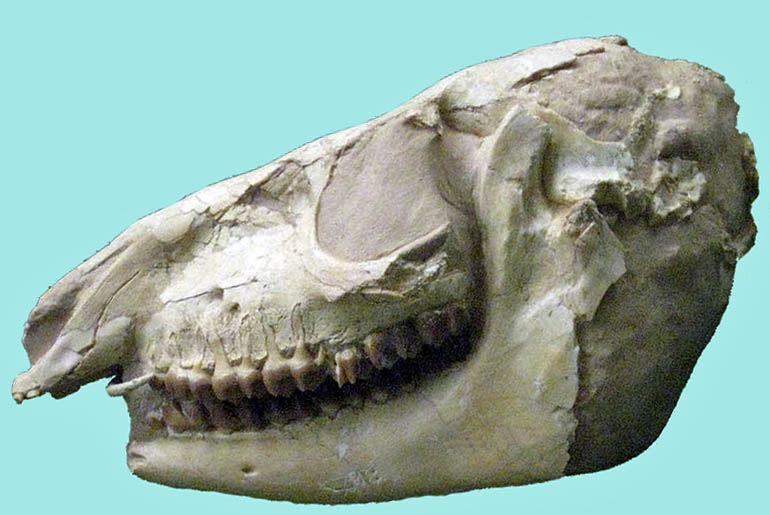
|
| Mesohippus bairdi Skull from the Oligocene (South Dakota)
|
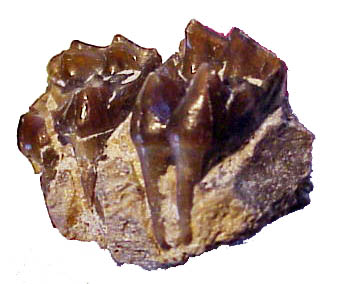
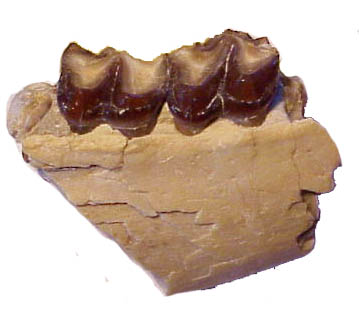
Fragment of the jaw and teeth of Mesohippus bairdi from the Oligocene
Brule, South Dakota
As grasslands replaced the woodland during the Oligocene Epoch horse species evolved larger jaws and more efficient teeth. Also important is that they evolved larger guts and a hindgut that enabled them to digest grass effectively. A bigger gut requires a larger animal to carry it. The grazing horse of the Oligocene Epoch (23-34 million years ago) was larger and had longer legs terminating in hooves that enabled them to quickly flee or even to cause damage to a predator. The modern wild horse Equus ferus first appeared in the fossil record about 3.5 million years ago. They were a very mobile animal that ranged widely in their habitat and were able to successfully populate their native North America, cross a land bridge to Eurasia and even made it to South America. It was Charles Darwin who first discovered a fossil horse tooth in South America and found its occurrence there very puzzling. The one continent that has no fossil horses is Australia. Horses were introduced there by British settlers in more modern times.
The taxonomic family to which horses belong is called Equidae and is considered to have eight different subfamilies of which modern horses, zebras, and donkeys have survived into modern times. Przewalski's Horse (the Takhi) is a wild subspecies of horse (Equus ferus przewalskii) that was native to Mongolia. It is making a successful comeback having become extinct in the wild and now reintroduced into its once native habitat. The Przewalski's Horse has existed as an isolated population and it appears from genetic studies that they have been separated from other populations for at least 43,000 years and it also has a total of 33 pairs of chromosomes as compared to domesticated horses, which have only 32. Horses disappeared from North America about 11,000 years ago during what is called the Pleistocene Extinction. Both climate change and the arrival of humans may account for this disappearance. The species found its new home in Eurasia and there it would encounter man. The full scientific name of the modern domestic horse is Equus ferus caballus.

|
Tooth of a Pliocene Horse
South Florida |
There is an additional species that figures into the story and that is man. Every so often you will read an excellent discussion in National Geographic, Discovery or other magazines that summarizes the most recent thinking about the evolution of man. I will not repeat this story but there are some interesting convergences between the two species. Both horse and man developed from forest dwellers and both horses and men matured as species in open grasslands. In the case of man this explains why we walk erect and why we are the naked ape. However, for the most part we are about as different as two species can be in every way. Paired together we become something nature never considered, a partnership of two beings, each complimenting the deficiencies of the other: intelligent, cunning, fast, and powerful.
The Accidental Horseman
Disclaimer: I have presented what I believe to be our modern scientific understanding of these events. Understand that science is very much like the game of pool. We may rack up our balls in a nice triangular arrangement, but there always seems to be someone who breaks the group up with a brand new white cue ball. Things like biological taxonomic classifications and religious doctrines seem equally capable of producing acrimonious and perhaps pointless scholarly debate.
CONTINUED: The History of Horse and Man
Back
Back to Additional Discussions








